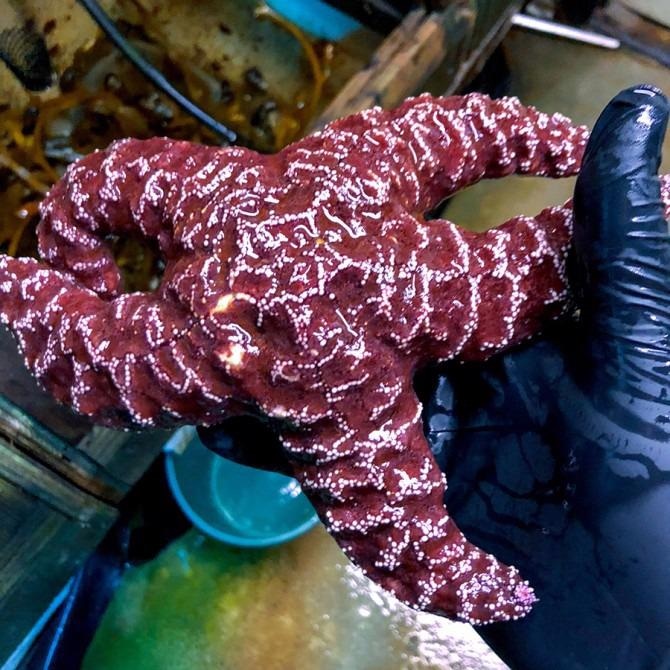Jan 7 2021
Across the globe, a mysterious wasting disease has almost destroyed sea star populations for over seven years. A few of these species are now on the verge of extinction.
 A healthy starfish is presented in Ian Hewson’s laboratory. Sea stars along the Pacific Coast are not so fortunate, as large amounts of organic matter may be robbing them of an ability to breathe. Image Credit: Ian Hewson Laboratory/Provided.
A healthy starfish is presented in Ian Hewson’s laboratory. Sea stars along the Pacific Coast are not so fortunate, as large amounts of organic matter may be robbing them of an ability to breathe. Image Credit: Ian Hewson Laboratory/Provided.
A new study under the guidance of Cornell University indicates that starfish, victims of sea star wasting disease (SSWD), might be in respiratory distress—literally 'drowning' in their own habitats—as increased microbial activity caused by proximate organic matter and warm ocean temperatures suppress the potential of the creatures to breathe.
"As humans, we breathe, we ventilate, we bring air into our lungs and we exhale. Sea stars diffuse oxygen over their outer surface through little structures called papulae, or skin gills. If there is not enough oxygen surrounding the papulae, the starfish can’t breathe."
Ian Hewson, Professor of Microbiology, College of Agriculture and Life Sciences, Cornell University
The study titled “Evidence That Microorganisms at the Animal-Water Interface Drive Sea Star Wasting Disease,” was published in the Frontiers in Microbiology journal on January 6th, 2021.
Hewson feels that ocean conditions result in the production of exceptional amounts of organic material, which prompts bacteria to thrive. Since organic matter is used up by bacteria, they deplete the oxygen present in the water, thereby making a low-oxygen micro-environment that encircles starfish and results in puffiness, discoloration, deflation and limb curling or twisting.
"It’s a cascade of problems that starts with changes in the environment."
Ian Hewson, Professor of Microbiology, College of Agriculture and Life Sciences, Cornell University
Hewson describes that the majority of the organic matter comes from microscopic algae exudation (a discharge), egestion and excretion of zooplanktons, and decaying carcasses of animals. This triggers a group of bacteria known as copiotrophs, which thrive on carbon and quickly consume organic matter, he added.
Hewson stated that the copiotrophs respire and so while absorbing the organic matter, they deplete oxygen in the watery space of the sea stars.
"It’s organic matter concentrations in the water. If you have a dead and rotting starfish next to starfish that are healthy, all of that dead one’s organic matter drifts and fuels the bacteria, creating a hypoxic environment. It looks like disease is being transmitted."
Ian Hewson, Professor of Microbiology, College of Agriculture and Life Sciences, Cornell University
He added that while more scientific studies should be performed, “This reframes the discussion about marine disease ecology, which has focused on pathogenic disease. We should now include microorganisms that don’t directly cause the pathology, since they may hold a key to affecting sea star health.”
Besides Hewson, Cornellians on this study include Christopher M. DeRito, researcher, Department of Microbiology; Ian R. Porter, assistant clinical professor, College of Veterinary Medicine; Jordan E. Rede, graduate student, Department of Microbiology; and Jed P. Sparks, professor, Department of Ecology and Evolutionary Biology.
The other contributors to the study include Citlalli A. Aquino, a graduate student from San Francisco State University; Ryan M. Besemer, an undergraduate student, the University of North Carolina at Wilmington; Jan Kocian, diver and photographer; Peter Raimondi, professor, University of California Santa Cruz; Lauren M. Schiebelhut, postdoctoral researcher, University of California, Merced; and John P. Wares, a professor from the University of Georgia.
The study was financially supported by the National Science Foundation and the U.S. Geological Survey.
Journal Reference:
Aquino, C. A., et al. (2021) Evidence That Microorganisms at the Animal-Water Interface Drive Sea Star Wasting Disease. Frontiers in Microbiology. doi.org/10.3389/fmicb.2020.610009.